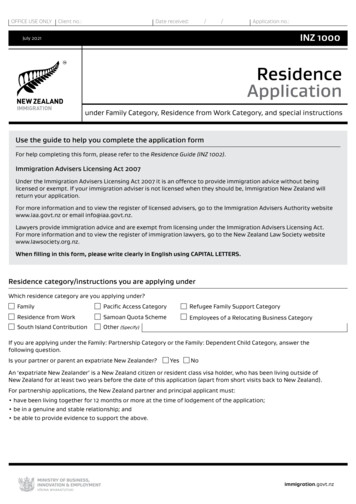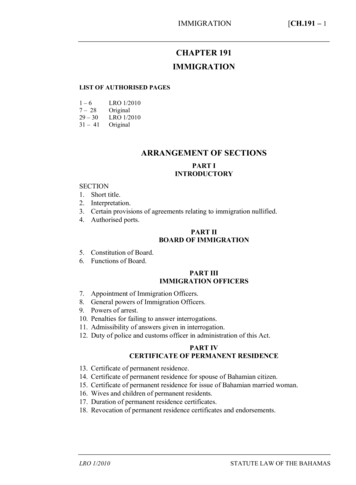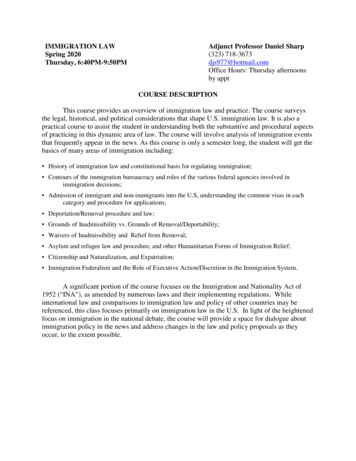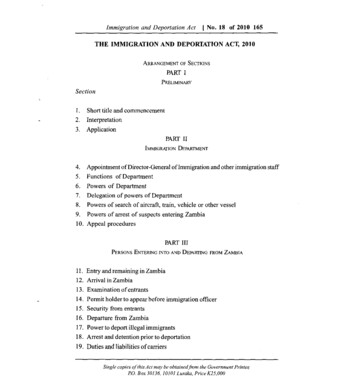
Transcription
Laws for Legal Immigration in the 27 EU Member StatesN 16InternationalMigrationLawLaws forLegal Immigrationin the 27 EUMember States1
While IOM endeavours to ensure the accuracy and completeness of the content of this paper, the views,findings, interpretations and conclusions expressed herein are those of the authors and field researchers anddo not necessarily reflect the official position of the IOM and their Member States. IOM does not accept anyliability for any loss which may arise from the reliance on information contained in this paper.Publishers: International Organization for Migration17 route des Morillons1211 Geneva 19SwitzerlandTel: 41.22.717 91 11Fax: 41.22.798 61 50E-mail: hq@iom.intInternet: http://www.iom.intISSN 1813-2278 2009 International Organization for Migration (IOM)All rights reserved. No part of this publication may be reproduced, stored in a retrieval system, or transmittedin any form or by any means, electronic, mechanical, photocopying, recording, or otherwise without the priorwritten permission of the publisher.17 09
N 16InternationalMigrationLawComparative Study of theLaws in the 27 EU Member Statesfor Legal ImmigrationIncluding an Assessment of the Conditions andFormalities Imposed by Each Member StateFor Newcomers
Laws for Legal Immigration in the 27 EU Member StatesList of ContributorsChristine Adam, International Migration Law and Legal Affairs Department, IOMAlexandre Devillard, International Migration Law and Legal Affairs Department, IOMField ResearchersAustriaGerhard MuzakProfessor, Vienna University, Institute of Constitutional and Administrative Law,AustriaBelgiumPhilippe De BruyckerProfessor, Université Libre de Bruxelles, Institute for European Studies, BelgiumBulgariaAngelina TchorbadjiyskaKatholieke Universiteit Leuven, Institute for European Law, BelgiumCyprusOlga GeorgiadesLawyer, Lellos P. Demetriades Law Office, Nicosia, CyprusCzech RepublicPavel ČižinskýLawyer, Counseling Centre for Citizenship/Civil and Human Rights, Prague, CzechRepublicDenmarkKristina TouzenisProject coordinator, IOM, Rome, ItalyEstoniaKlen JääratsPermanent Representation of Estonia to the EU, Brussels, Belgium* The views expressed in the Country Report do not necessary reflect the opinions ofthe Estonian GovernmentFinlandReetta ToivanenAffiliated Senior Research Fellow, Åbo Akademi University, Institute for HumanRights, Turku, FinlandFranceAlexandre DevillardInternational Migration Law and Legal Affairs Department, IOM, Geneva5
GermanyRolf GutmannLawyer, Stuttgart, GermanyGreeceKonstantinos D. MagliverasAssistant Professor, University of the Aegean, Mytilene, GreeceHungayJudit Mária TóthAssociate Professor, Faculty of Law, University of Szeged, HungaryIrelandCatherine CosgravePolicy Officer, Immigrant Council of Ireland, Dublin, IrelandBernard RyanReader in Law, University of Kent, Canterbury, UK* The views expressed in the Country Report do not necessary reflect the opinions ofthe Irish GovernmentItalyKristina TouzenisProject coordinator, IOM, Rome, Italy* With thanks to Silvia Spinuso, IOM Rome, for her assistanceLatviaIvars IndansResearcher, Latvian Institute of International Affairs, Riga, LatviaLithuaniaVioleta TargonskieneLecturer, Mykolas Romeris University, Vilnius, LithuaniaLuxembourgAlexandre DevillardInternational Migration Law and Legal Affairs Department, IOM, GenevaMaltaRuth FarrugiaSenior Lecturer, University of Malta, Faculty of Laws, MaltaNetherlandsTessel de LangeResearcher, Radboud University Nijmegen, Center for Migration Law, Netherlands6
Laws for Legal Immigration in the 27 EU Member StatesPolandMagdalena KmakLawyer, Helsinki Foundation for Human Rights, Warsaw, PolandAgata ForyśLawyer, Helsinki Foundation for Human Rights, Warsaw, PolandPortugalIsabel EstrelaLawyer, Queluz, PortugalRomaniaEmőd VeressSenior Lecturer, Sapientia University, Faculty of Economics, Miercurea-Ciuc,RomaniaSlovakiaBoris DivinskýComenius University, Faculty of Sciences, Bratislava, SlovakiaMiroslava ŠnírerováTrnava University, Faculty of Law, SlovakiaSloveniaNeža KogovšekResearcher, The Peace Institute - Institute for Contemporary Social and PoliticalStudies, Ljubljana, SloveniaSpainEloy Ruiloba GarciaProfessor, University of Malaga, SpainSwedenChristina JohnssonAssistant Professor, Lund University, Raoul Wallenberg Institute, SwedenUnited KingdomBernard RyanReader in Law, University of Kent, Canterbury, UK7
AcknowledgementsMany persons, within and outside IOM, have to be acknowledged for their inputs andcomments: Richard Perruchoud, Jillyanne Redpath-Cross, Ryszard Cholewinski, SophieNonnenmacher, Alexia Scarlett, Paola Pace, Helen Armstrong, Suzanna Chapman,Stephanie Gonzalez and Adrian Melendez.8
Laws for Legal Immigration in the 27 EU Member StatesTable of ContentsList of Contributors. 5Acknowledgements. 8Abbreviations. 11Executive Summary. 13Introduction. 15Emerging EU Law and Policy on Migration. 191. Development of an EU Law and Policy on Migration. 192. Ongoing Debate on Legal Migration at the EU Level. 21Comparison. 291. General Immigration Policy and Trends. 292. Comparison. 322.1 Overview of Immigration Categories. 322.2 Visa Policy. 332.3 Residence Rules. 392.3.1 General Conditions and Procedures, regardless of the ImmigrationCategory. 392.3.2 Conditions according to Length of Residence. 502.3.3 Conditions for Specific Immigration Types. 602.3.3.1 Family Reunification. 602.3.3.2 Work. 722.3.3.2.1 Employment. 732.3.3.2.2 Self-Employment. 902.3.3.2.3 Seasonal Employment. 942.3.3.3 Studies and Training. 1002.3.3.3.1 Studies. 1012.3.3.3.2 Training. 1073. Cooperation with Third Countries. 109Recommendations. 117Bibliography. 122Country Reports. 135Austria. 137Belgium. 153Bulgaria. 167Cyprus. 181Czech Republic. 197Denmark. 211Estonia. 2279
Finland. 249France. 263Germany. 279Greece. 293Hungary. 309Ireland. 321Italy. 337Latvia. 351Lithuania. 367Luxembourg. 379Malta. 389Netherlands. 401Poland. 419Portugal. 435Romania. 445Slovakia. 459Slovenia. 473Spain. 487Sweden. 501United Kingdom. 515Annexes. 531Table A: Other Categories of Legal Immigration. 532Table B: General Conditions for Residence. 535Table C: Permanent Residence. 546Table D: Family Reunification. 561Table E: Employment. 586Table F: Self-Employment. 609Table G: Seasonal Employment. 623Table H: Studies. 62910
Laws for Legal Immigration in the 27 EU Member IDECECHRECMWEEAEECEMNENPESCESC VMWCNAGOECDOINOJOSCEProgramme of the European Union for financial and technical assistanceto third countries in the area of migration and asylum(Euro-Mediterranean) Consortium for Applied Research on InternationalMigrationInternational Covenant on Civil and Political RightsCentre for European Political StudiesCommunity of Portuguese-Speaking CountriesCommunication from the European CommissionDisegno di Legge (Bill authorizing the Italian Government to draft a law)Department for International Development (UK)European CommunityEuropean Convention on Human RightsEuropean Convention on the Legal Status of Migrant WorkersEuropean Economic AreaEuropean Economic CommunityEuropean Migration NetworkEuropean Neighbourhood PolicyEuropean Social CharterEuropean Social Charter (Revised)European UnionEuroGeneral Agreement on Trade in Services (WTO)Human Immunodeficiency Virus/Acquired Immunodeficiency SyndromeInternational Covenant on Civil and Political RightsIntergovernmental ConsultationsInternational Graduates Scheme (UK)International Labour OrganizationImmigration and Naturalization Department (Netherlands)Irish Naturalisation and Immigration ServiceInternational Organization for MigrationJustice and Home AffairsAuthorization for temporary stay in the Netherlands (Machtiging totVoorlopig Verblijf)International Convention on the Protection of the Rights of all MigrantWorkers and Members of their FamiliesFederal Act concerning settlement and residence in Austria(Niederlassungs- und Aufenthaltsgesetz)Organization for Economic Co-operation and DevelopmentOffice of Immigration and Nationality (Hungary)Official Journal (of the European Communities)Organisation for Security and Co-operation in Europe11
Cooperation on Preventing Illegal employment of Labour Migrants with aView to Promoting Legal Employment Opportunities (IOM Report)Seasonal Agricultural Workers SchemeSchengen Information SystemSwedish Migration BoardSystème d’Observation Permanente sur les Migrations (OECD’sContinuous Reporting System on Migration)Parliamentary Documents (Netherlands)Training or Work Experience Scheme (UK)United KingdomUnited NationsUnited Nations Joint Programme on HIV/AIDSUnited Nations Educational, Scientific, and Cultural OrganizationUnited States of America
Laws for Legal Immigration in the 27 EU Member StatesExecutive SummaryThis study was commissioned by the European Parliament and aims at providing anoverview and analysis of the conditions for legal immigration in the 27 Member States.The analysis has been undertaken with a view to examining the benefits and possibilitiesof common policies at the EU level for different immigration categories.Migration is high on both national and EU agendas. The decline and aging of theEuropean population has contributed to an increased awareness concerning the need forimmigration. The demographic factor, coupled with its foreseeable implications on thevarious social welfare systems, has provoked increased debate concerning immigrationwithin EU institutions and EU Member States alike. There is a growing awarenessthat without migrants, Europe will not be able to maintain the same standard of living.However, as much as European States are competing with other business locations (suchas the USA and Japan) for highly skilled third-country nationals, a trend can be seenamong some Member States towards more restrictive policies with regard to other formsof legal immigration, such as family reunification. Member States are struggling to finda well-balanced and comprehensive approach to migration that will serve such diverseobjectives as attracting highly skilled migrants, preventing irregular migration andsafeguarding the human rights of migrants.The European Commission argues that “in a single market with free movement ofpersons, there is a clear need to go beyond 27 immigration policies” (Towards a CommonImmigration Policy 2007, p. 7) and that further development of a common EuropeanMigration Policy is needed. A common policy can render the immigration regulationssimpler and more transparent for immigrants and competent authorities alike. Whilstthe development of an EU immigration policy for certain immigration types (familyreunification, studies and training and researchers) and third-country nationals (long-termresidents) is progressing, Member States have for a long time been reluctant to give upcompetencies in the field of labour migration. With the Policy Plan on Legal Migration,two proposed Directives and further developments to come, this position seems set tochange.It can be noted, however, that even in areas that are subject to EU-wide regulations,significant differences in the national legislation of Member States can be observed.To highlight a few areas, with respect to long-term residents, a substantial number ofcountries continue to use national permanent residence permits in addition to the EClong-term residence permit. Moreover, Member States draw a distinction betweentemporary residence and permanent residence; there is, however, no standardized conceptof temporary residence. Also, the conceptual distinction between visas and residencepermits is ambiguous. Furthermore, in the area of family reunification, Member Stateshave – as outlined in by Council Directive 2003/86/EC on the right to family reunification– significant discretion with regard to certain important aspects, such as eligibility offamily members that are not part of the nuclear family (e.g. parents, adult childrenand unmarried partners), age restrictions for spouses and children, as well as waitingperiods before family members can join the sponsor. A trend can be observed in several13
EU Member States towards the restriction of immigration for the purpose of familyreunification, for example, through the introduction of integration-related conditions.Interestingly, EU Member States are increasingly offering students the possibility ofremaining in the country for a limited period of time after successful graduation in orderto search for a job, even though this is not foreseen in Council Directive 2004/114/ECon the conditions of admission of third-country nationals for the purposes of studies,pupil exchange, unremunerated training or voluntary service. This measure facilitates theretention of highly qualified third-country nationals who have the potential to contributeto the national (and European) economy.There are many areas related to migration that are not regulated by EU law, such asthe general conditions for residence permits and, more significantly, labour migration(including employment, self-employment and seasonal work). This study aims tohighlight trends that are valid for several or all Member States. As regards generalconditions, research shows that while the vast majority of EU Member States do notimpose integration-related conditions as general conditions, a trend can be noted towardsthe inclusion of these conditions into national legislation. Integration-related conditions,in particular examinations on language and civic knowledge, can present an importantobstacle for potential immigrants. In relation to immigration for the purpose of work,it can be concluded that the regulations regarding immigration for the purpose ofemployment in the EU Member States are rather complex. The current regulations are achallenge for employers and third-country national workers alike, as different permits areoften required, with the involvement of various authorities. However, labour immigrationpolicies and laws in the different Member States are similar in that they are all verymuch linked to the protection of national labour markets. With respect to the work permitsystem, it is noteworthy that in many Member States the foreigner is tied to the employer.The current labour migration discussion and preferential admission policies are focusedfirst and foremost on highly skilled labour. Some Member States have concluded bilateralagreements with third countries that have a more comprehensive approach to migrationmanagement; by and large, these agreements offer facilitation regarding labour migrationfor nationals of a third-country in exchange for the cooperation of that country in theprevention of irregular migration. These agreements go in the direction of the “mobilitypartnerships” proposed by the Commission. The subject of migration of less skilled labour,however, is not sufficiently covered. It is noticeable that in the foreseen frameworks atthe EU level, less skilled labour is only considered with respect to seasonal employment.14It should also be noted that the external dimension of migration (cooperation with thirdcountries) has become an increasingly important item on the EU agenda in recent years.When studying the actual cooperation between Member States and third countries, thegap between the importance attached to this topic at the EU level and the actual measuresin place at the national level is noteworthy. However, the issue is gaining importanceand is increasingly also included in national agendas. Several initiatives and tools havebeen proposed by the Commission on this matter. At this stage, it is important that theinitiatives proposed by the Commission are put into practice by Member States. Thepractical experiences gathered will then allow further discussion and refining of thoseinstruments.
Laws for Legal Immigration in the 27 EU Member StatesIntroductionScope of the StudyIn December 2006, the European Parliament’s Directorate General for Internal Policies,Citizens’ Rights and Constitutional Affairs commissioned the International Organizationfor Migration (IOM) to conduct a “Comparative Study of the Laws in the 25 EU MemberStates for Legal Immigration including an Assessment of the Conditions and FormalitiesImposed by each Member State for Newcomers.”1 The aim of the study funded by theEuropean Parliament is to serve as a research tool for the Members of the EuropeanParliament in the development of a European Union (EU) policy on migration.The present study is based on the following observation: at present, a wide variety ofapproaches to migration management exist, and are being developed, across the 27 EUMember States. The conditions and procedures regarding the admission and residence offoreigners into the receiving States differ from country to country.The comparative study of the legislation of the 27 EU Member States and its practicalimpact will therefore facilitate the implementation and development of the emerging EUlegal immigration scheme.The scope of this study, which covers many different immigration categories, isundoubtedly wide. It is firstly framed by the concept of immigration itself, which canbe briefly defined as the “process by which non-nationals move into a country for thepurpose of settlement” (Glossary on Migration 2004, p. 34). The notion of settlement isimportant as it implies the exclusion of certain types of international movements, such asthose for the purpose of tourism or visits. It can be noted that, despite its wide character,the concept of immigration can still be considered as too narrow in view of the termsof reference. For example, in the case of seasonal workers there is no change of theindividual’s place of habitual residence, thus such a movement is not considered strictosensu as migration. Consequently, the notion of immigration needs to be extended slightlyfor the purposes of this study, in order to embrace all the types of foreigners covered by it.Secondly, the use of the concept of immigration adopted within the European Union alsodefines the scope of this study. In this context, the notion of immigration is limited to themovement of third-country nationals (persons who are not nationals of an EU MemberState), as European citizens are subjected to a specific legal regime according to theprinciple of free movement of persons.2 This study consequently focuses on the situationof third-country nationals.A further way in which to demarcate the scope of this study is its emphasis on legalimmigration, implying the exclusion of irregular migration and of involuntary migrationissues (which principally refers to asylum policies). The study focuses on the following12Subsequently extended to include the two newly acceded countries, Bulgaria and Romania.This European legal regime is extended to nationals of the European Free Trade Association (EFTA)Member States.15
categories of legal immigration: family immigration, economic immigration (employment,self-employment and seasonal employment) and immigration for the purpose of studiesand training.The focus of the study is the analysis of the conditions and procedures of admission andresidence under different immigration categories. As a result, the social rights granted tothird-country nationals are not analysed; furthermore, the right to exercise a professionalactivity will be analysed, whereas the rights associated with work (such as the right to justand favorable conditions of work) will not.Structure and MethodologyThe first part of this study aims to contextualize the topic through an analysis ofemerging EU law and policy. The ongoing debate on legal migration at the EU level isstudied. Thereafter follows the main part of the study: the comparison of the differentlegal immigration systems within the EU Member States. The comparison follows thesame outline as the Country Reports and leads to recommendations that outline the keyprinciples that should govern the conditions and procedures of admission and residence ofthird-country nationals within the EU territory. The final part of this study is composed of27 Country Reports that examine in detail the national policy and legislation on migrationfor each EU Member State, following the structure outlined below. Finally, the Annexesto the study include eight tables that succinctly bring together the main findings of theCountry Reports.16The Country Reports include the following elements: each is introduced by an overviewof the historical background and contemporary trends regarding migration flows and thenational immigration policy, as well as an outline of the different immigration categoriesenvisaged by the national legislation (family reunification, work, studies and training andother). This is followed by a description and analysis of the conditions and proceduresapplicable in admission (visa policy) and residence matters (residence permits policy).This section of the Country Reports includes an analysis of the general conditions to befulfilled by the migrant in the country of origin, as well as upon arrival in the countryof destination, regardless of the immigration categories (such as financial requirements,medical exams, civic knowledge and knowledge of the language of the host country andthe possible grounds for rejection of an application). Procedural aspects of admissionand residence are also covered, including a description and analysis of the competentauthorities, length of procedures and appeal of decisions to reject an application. A furtherdetailed review of residence permits is conducted according to the specific immigrationcategories, either on the basis of length of residence (whether temporary or permanent)or on the basis of the purpose of stay (family reunification, work, studies and training).The subsequent section of each Country Report comprises a comparison of conditionsin the EU Member States with the norms established at the EU and international levels.It should be noted that this part of the study is not central, as the report is primarilya comparison of national laws. The practical impact of the legislation, such as itsconsequences on immigration trends, difficulties of implementation and the existenceof human rights gaps, is also assessed. Finally, the Country Reports are concluded by
Laws for Legal Immigration in the 27 EU Member Statesan analysis of the cooperation measures with third countries, such as the existence ofbilateral labour migration agreements, highly skilled worker programmes, schemes forcircular migration, facilitation of the transfer of remittances and access to social securityand pension rights upon return to the country of origin.This study is based on the description and assessment of the national legislation provided,country by country, by field researchers. For each of the 27 EU Member States, thecountry study was prepared by an expert in migration law, either an academic or a legalpractitioner (see the list of researchers above). On this basis, IOM’s research team hasedited the country reports to provide a consistent structure and has produced a comparisonbetween the different legal systems. While considerable effort has been invested to ensureconsistency between the Country Reports, it is to be highlighted that the editors had todeal with 27 different countries, systems and terminologies. Standardization was hencedifficult and only possible to a certain extent.The present study considers national legislation until August 2007. The Euro is not thecurrency of all EU Member States. Where applicable, fees and other amounts expressedin local currencies have been converted into Euros. For the relevant exchange rates pleaserefer
Migration Policy is needed. A common policy can render the immigration regulations simpler and more transparent for immigrants and competent authorities alike. Whilst the development of an EU immigration policy for certain immigration types (family reunification, studies and training and researchers) and third-country nationals (long-term










